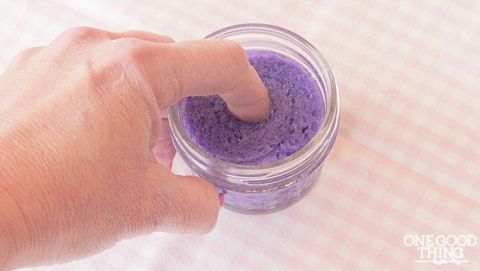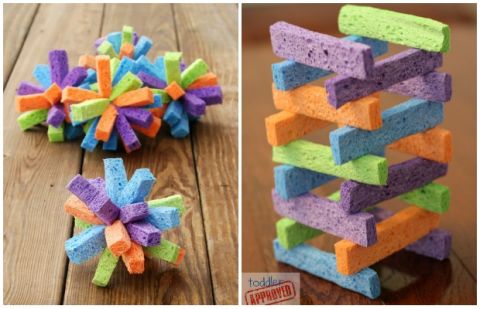Sponges
might be the best at cleaning spills and soaping up dishes, but if you
confine them to your kitchen, you're missing out on their other hidden
skills. These clever uses will have you stocking up next time you hit
the cleaning aisle:
1. Remove pills from sweaters.
Textured scrub sponges (like these) make quick work of tidying up a worn sweater. Gently run it across the garment to banish fuzz.
Textured scrub sponges (like these) make quick work of tidying up a worn sweater. Gently run it across the garment to banish fuzz.
2. Keep houseplants well-watered.
If you sneak a sponge into the bottom of a planter, it will soak up excess water when you give your plant a drink. This can prevent roots from rotting in too much moisture, and offers back-up sustenance if you forget to water your greenery.
If you sneak a sponge into the bottom of a planter, it will soak up excess water when you give your plant a drink. This can prevent roots from rotting in too much moisture, and offers back-up sustenance if you forget to water your greenery.
3. Lift pet hair off carpeting.
A damp sponge is just the tool you need to pull pesky hair out of your carpet's fibers.
A damp sponge is just the tool you need to pull pesky hair out of your carpet's fibers.
4. Make a no-drip ice pack.
Carole at My Kitchen Escapades likes freezing saturated kitchen sponges in plastic zip-top bags. As the ice melts, the moisture stays sopped up the sponge, minimizing mess.
Carole at My Kitchen Escapades likes freezing saturated kitchen sponges in plastic zip-top bags. As the ice melts, the moisture stays sopped up the sponge, minimizing mess.
5. Cushion breakables.
If you're storing, say, a ceramic bowl or collection of figurines, strategically place sponge pieces near any fragile parts or sharp corners that could easily damage.
If you're storing, say, a ceramic bowl or collection of figurines, strategically place sponge pieces near any fragile parts or sharp corners that could easily damage.
6. Sop up rain.
Place a sponge at the bottom of an umbrella stand to protect the bottom from getting moist and mildewy. It's much easier to toss and replace the sponge when necessary than to give the canister a regular deep cleaning.
Place a sponge at the bottom of an umbrella stand to protect the bottom from getting moist and mildewy. It's much easier to toss and replace the sponge when necessary than to give the canister a regular deep cleaning.
7. Make a nail-polish remover jar.
Jilllee at One Good Thing found a clever way to ditch the cotton-ball technique for removing nail polish. Instead, she made her own dip-and-twist jar by sticking a sponge soaked in remover inside a mason jar.
Jilllee at One Good Thing found a clever way to ditch the cotton-ball technique for removing nail polish. Instead, she made her own dip-and-twist jar by sticking a sponge soaked in remover inside a mason jar.
8. Protect surfaces from scratches.
Before you place a vase on your vintage coffee table, glue a few pieces of a sponge to the bottom to curtail any bumps and bruises.
Before you place a vase on your vintage coffee table, glue a few pieces of a sponge to the bottom to curtail any bumps and bruises.
9. Plug a drafty window.
If your window air-conditioning unit doesn't fit snuggly, press a sponge into any leaky holes to keep the chilly air inside.
If your window air-conditioning unit doesn't fit snuggly, press a sponge into any leaky holes to keep the chilly air inside.
10. Entertain kids.
Surprisingly, when cut and tied into different shapes, sponges make for safe outdoor fun (like these water bombs) and extra-quiet games (like these building blocks that won't give you headache when they come crashing down).
Surprisingly, when cut and tied into different shapes, sponges make for safe outdoor fun (like these water bombs) and extra-quiet games (like these building blocks that won't give you headache when they come crashing down).
11. Give yourself an at-home pedicure.
Place pieces of a cut-up sponge between your toes so you don't smudge your polish before it dries.
Place pieces of a cut-up sponge between your toes so you don't smudge your polish before it dries.
This information is from a Good Housekeeping article. Rather than rewrite the article, I printed it in its entirety. Great information. I especially like number two and number seven.





No comments:
Post a Comment